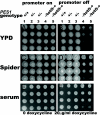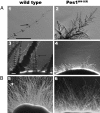The Candida albicans pescadillo homolog is required for normal hypha-to-yeast morphogenesis and yeast proliferation
- PMID: 19075239
- PMCID: PMC2634893
- DOI: 10.1073/pnas.0809147105
The Candida albicans pescadillo homolog is required for normal hypha-to-yeast morphogenesis and yeast proliferation
Abstract
A single species, Candida albicans, causes half of all invasive fungal infections in humans. Unlike other fungal pathogens, this organism switches between growth as budding yeast and as pseudohyphal and hyphal filaments in host organs and in vitro. Both cell types play a role in invasive disease: while hyphal and pseudohyphal filaments penetrate host cells and tissues, yeast cells are likely to facilitate dissemination through the bloodstream and establishment of distant foci of infection. Many regulators of the yeast-to-hypha switch have emerged from intensive investigations of this morphogenetic step, but the hypha-to-yeast switch remains poorly understood. Using a forward genetic approach, a novel putative regulator involved in the hypha-to-yeast switch was identified, the C. albicans pescadillo homolog, PES1. In eukaryotes from yeast to human, pescadillo homologs are involved in cell cycle control and ribosome biogenesis, and are essential. We find a pescadillo homolog to act in fungal morphogenesis, specifically in lateral yeast growth on filamentous cells. We also find essentiality of PES1 in C. albicans to be dependent on cell type, because hyphal cells, but not yeast cells, tolerate its loss. PES1 is therefore critical for completion of the C. albicans life cycle, in which the fungus switches between filamentous and yeast growth. Consistent with these in vitro findings, PES1 is required for C. albicans virulence in an in vivo insect model of infection.
Conflict of interest statement
The authors declare no conflict of interest.
Figures






Similar articles
-
Physiologic expression of the Candida albicans pescadillo homolog is required for virulence in a murine model of hematogenously disseminated candidiasis.Eukaryot Cell. 2012 Dec;11(12):1552-6. doi: 10.1128/EC.00171-12. Epub 2012 Oct 26. Eukaryot Cell. 2012. PMID: 23104566 Free PMC article.
-
The Flo8 transcription factor is essential for hyphal development and virulence in Candida albicans.Mol Biol Cell. 2006 Jan;17(1):295-307. doi: 10.1091/mbc.e05-06-0502. Epub 2005 Nov 2. Mol Biol Cell. 2006. PMID: 16267276 Free PMC article.
-
Messenger RNA transport in the opportunistic fungal pathogen Candida albicans.Curr Genet. 2017 Dec;63(6):989-995. doi: 10.1007/s00294-017-0707-6. Epub 2017 May 16. Curr Genet. 2017. PMID: 28512683 Free PMC article. Review.
-
Temporal dynamics of Candida albicans morphogenesis and gene expression reveals distinctions between in vitro and in vivo filamentation.mSphere. 2024 Apr 23;9(4):e0011024. doi: 10.1128/msphere.00110-24. Epub 2024 Mar 19. mSphere. 2024. PMID: 38501830 Free PMC article.
-
Growth of Candida albicans hyphae.Nat Rev Microbiol. 2011 Aug 16;9(10):737-48. doi: 10.1038/nrmicro2636. Nat Rev Microbiol. 2011. PMID: 21844880 Review.
Cited by
-
Candida albicans' inorganic phosphate transport and evolutionary adaptation to phosphate scarcity.PLoS Genet. 2024 Aug 13;20(8):e1011156. doi: 10.1371/journal.pgen.1011156. eCollection 2024 Aug. PLoS Genet. 2024. PMID: 39137212 Free PMC article.
-
Yeast and Filaments Have Specialized, Independent Activities in a Zebrafish Model of Candida albicans Infection.Infect Immun. 2018 Sep 21;86(10):e00415-18. doi: 10.1128/IAI.00415-18. Print 2018 Oct. Infect Immun. 2018. PMID: 30037799 Free PMC article.
-
Molecular Mapping of Antifungal Mechanisms Accessing Biomaterials and New Agents to Target Oral Candidiasis.Int J Mol Sci. 2022 Jul 7;23(14):7520. doi: 10.3390/ijms23147520. Int J Mol Sci. 2022. PMID: 35886869 Free PMC article. Review.
-
Antagonism of Fluconazole and a Proton Pump Inhibitor against Candida albicans.Antimicrob Agents Chemother. 2015 Nov 23;60(2):1145-7. doi: 10.1128/AAC.02043-15. Print 2016 Feb. Antimicrob Agents Chemother. 2015. PMID: 26596946 Free PMC article.
-
Candida albicans' inorganic phosphate transport and evolutionary adaptation to phosphate scarcity.bioRxiv [Preprint]. 2024 Feb 1:2024.01.29.577887. doi: 10.1101/2024.01.29.577887. bioRxiv. 2024. Update in: PLoS Genet. 2024 Aug 13;20(8):e1011156. doi: 10.1371/journal.pgen.1011156. PMID: 38352318 Free PMC article. Updated. Preprint.
References
-
- Wisplinghoff H, et al. Nosocomial bloodstream infections in US hospitals: analysis of 24,179 cases from a prospective nationwide surveillance study. Clin Infect Dis. 2004;39(3):309–317. - PubMed
-
- Odds FC. London: Bailliere Tindall; 1988. Candida and Candidosis.
-
- Kumamoto CA, Vinces MD. Contributions of hyphae and hypha-co-regulated genes to Candida albicans virulence. Cell Microbiol. 2005;7(11):1546–1554. - PubMed
Publication types
MeSH terms
Substances
Grants and funding
LinkOut - more resources
Full Text Sources
Other Literature Sources
Medical
Molecular Biology Databases
Miscellaneous

